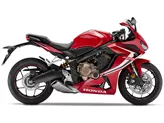Yamaha R1 2011 vs. Kawasaki Ninja 650 2017

Yamaha R1 2011

Kawasaki Ninja 650 2017
Visão geral - Yamaha R1 2011 vs Kawasaki Ninja 650 2017
The Yamaha R1 model year 2011 and the Kawasaki Ninja 650 model year 2017 are both popular sport bikes, but they have significant differences in terms of technical specifications and strengths.
Starting with the Yamaha R1 2011, it features a powerful motor with a bore of 78 mm and a stroke of 52.2 mm, delivering an impressive 181 horsepower and 115.5 Nm of torque. The bike is equipped with a 4-cylinder engine and has 4 valves per cylinder, with a DOHC valve configuration. With a displacement of 998 cc, the R1 offers excellent performance on the road. The front suspension consists of an upside-down telescopic fork, providing stability and precise handling. The frame is made of aluminum, contributing to the bike's lightweight and agile nature. The R1 is equipped with dual disc brakes on the front, ensuring reliable stopping power. In terms of dimensions, it has a front tire width of 120 mm and a rear tire width of 190 mm, both with a diameter of 17 inches. The wheelbase measures 1415 mm, and the seat height is 835 mm. The fuel tank has a capacity of 18 liters.

Yamaha R1 2011
On the other hand, the Kawasaki Ninja 650 2017 has a different set of specifications. Its motor has a larger bore of 83 mm and stroke of 60 mm, resulting in a power output of 68.2 horsepower and 65.7 Nm of torque. The Ninja 650 features a 2-cylinder engine with 4 valves per cylinder and a DOHC valve configuration. With a displacement of 649 cc, it offers a good balance between power and efficiency. The front suspension consists of a telescopic fork, providing a comfortable ride and responsive handling. The frame is made of steel, offering durability and stability. Similar to the R1, the Ninja 650 is equipped with dual disc brakes on the front, ensuring reliable stopping power. In terms of dimensions, it has the same front tire width of 120 mm and a slightly narrower rear tire width of 160 mm, both with a diameter of 17 inches. The wheelbase measures 1410 mm, and the seat height is 790 mm. The fuel tank has a capacity of 15 liters.
In terms of strengths, the Yamaha R1 2011 stands out for its precise handling and easy adaptation to the race track. Its fine traction point and optimal traction make it a favorite among sport bike enthusiasts. On the other hand, the Kawasaki Ninja 650 2017 offers a transparent sport chassis, providing a playful and enjoyable riding experience. Its excellent brakes and stylish appearance, reminiscent of the ZX-10R, make it an attractive choice. Additionally, the Ninja 650's engine is known for its durability.

Kawasaki Ninja 650 2017
However, both bikes have their weaknesses. The Yamaha R1 2011 has a rear end with a chubby appearance, which may not appeal to some riders. On the other hand, the Kawasaki Ninja 650 2017 has a lack of sound from the exhaust system as standard and the engine may exhibit slight vibrations.
Overall, the Yamaha R1 2011 and the Kawasaki Ninja 650 2017 offer different riding experiences. The R1 is a high-performance supersport bike, ideal for those seeking top-notch performance on the race track. On the other hand, the Ninja 650 is a more versatile sport bike, suitable for both daily commuting and spirited riding.
Especificações técnicas Yamaha R1 2011 em comparação com Kawasaki Ninja 650 2017
Prós e contras em comparação
Prós e contras em comparação
Yamaha R1 2011

Era uma vez, ela era a besta mais dura entre as 1000. Só os cães mais selvagens podiam andar nela. Agora, é a mota que não só pode ser descrita como "o menor mal na estrada rural", mas que também dá muito prazer.
Kawasaki Ninja 650 2017

A Ninja 650 é um selo firme da sua antecessora (Er-6f). O motor dominou bem a barreira do Euro 4 e oferece 68 cv muito úteis, o chassis é simplesmente fantástico para esta classe e a redução de peso de 18(!) quilos em comparação com a ER-6f justifica acenos de cabeça reverentes.
Comparação de preços Preço médio de mercado Yamaha R1 vs Kawasaki Ninja 650
There are a few key differences between a Yamaha R1 2011 and a Kawasaki Ninja 650 2017. In terms of price, the actual average price of a Yamaha R1 2011 is about 34% higher. A Yamaha R1 2011 experiences a loss of 1 360 EUR in one year and 2 300 EUR in two years of ownership. This is offset by a loss of 480 EUR and 620 EUR for a Kawasaki Ninja 650 2017. Compared to Kawasaki Ninja 650 2017 there are less Yamaha R1 2011 bikes available on the 1000PS.de Marketplace, specifically 4 compared to 7. It takes less time to sell a Yamaha R1 with 53 days compared to 96 days for a Kawasaki Ninja 650. Since model year 2005 1000PS.de editors have written 80 reviews for the Yamaha R1 and 20 reviews for the Kawasaki Ninja 650 since model year 2017. The first review for the Yamaha R1 was published on 28/04/2003 and now has more than 3 900 views. This compares to more than 79 600 views for the first review on Kawasaki Ninja 650 published on 04/10/2016.






















